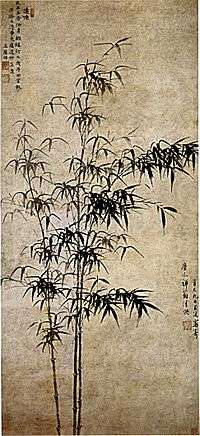Wang Fu (painter)
Wang Fu (simplified Chinese: 王绂; traditional Chinese: 王紱; pinyin: Wáng Fú; Wade–Giles: Wang Fu); ca. 1362-1416 was a Chinese landscape painter, calligrapher, and poet during the Ming Dynasty (1368–1644).

Wang Fu, Ink Bamboo, Palace Museum, 1401
| Wikimedia Commons has media related to Wang Fu. |
Wang was born in Wuxi in the Jiangsu province.[1] His style name was 'Mengduan' (孟端) and his pseudonyms were 'Youshi (友石), Jiulong shanren (九龙山人), and Aosou' (鳌叟).[2] Wang's painting followed the style of Wang Meng and Ni Zan. Wang also painted ink bamboo works in a free and uninhibited style.
Notes
- "Wang Fu Brief Biography". Retrieved 2008-07-09.
- Cihai: Page 1194.
gollark: Macron idea: rotational position embeddings.
gollark: Macron idea: Riemann zeta function built-in.
gollark: It's too late. I already implemented it.
gollark: Macron idea: the only thing you can do atomic operations is a global bit shared with the entire program.
gollark: The Committee disagrees.
References
- Ci hai bian ji wei yuan hui (辞海编辑委员会). Ci hai (辞海). Shanghai: Shanghai ci shu chu ban she (上海辞书出版社), 1979.
- Jonathan Chaves “Painter-Poet Wang Fu (1362-1416),” (essay with translations), Oriental Art, Vol. XLV, No. 4, 1999/2000.
This article is issued from Wikipedia. The text is licensed under Creative Commons - Attribution - Sharealike. Additional terms may apply for the media files.